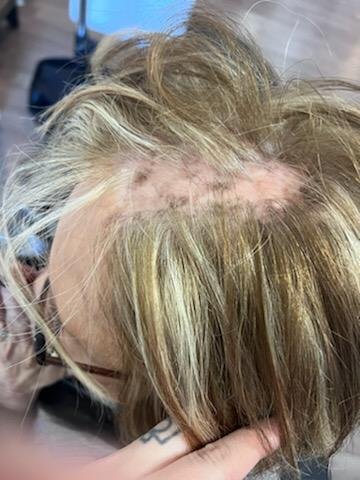Hair Thinning On One Side Of Head – Causes & Treatments
Home / Blog / Hair Thinning On One Side Of Head – Causes & Treatments
Hair thinning and hair loss that only affects one side of the scalp is called one-sided hair loss. One side of your head may lose hair totally or slightly more than the other. The losing hair side of the head might appear more diffusely or in distinct patches over broader parts of the head. In either case, the outcome is that the hair seems asymmetrical.
Most hair loss conditions have a consistent pattern, making a diagnosis simple. But determining the cause might be difficult when hair loss does not follow a usual pattern, such as one-sided hair thinning. Knowing the cause of balding on the side of the head is crucial for effectively treating any hair loss. The best strategy to reduce hair loss and promote regeneration in many cases is to treat the underlying reason. On that note, let's look at the common causes of hair loss on one side of the head.
Here Are Some Of The Most Common Causes Of One-Sided Hair Loss-
Genetics, stress, and sickness are just a few of the numerous potential reasons why someone could lose hair on one side of their head. However, issues including irregular hair development, hormonal imbalances, and inflamed scalp can also be some of the most prevalent causes of losing hair side of the head. Let's look at them in detail.
ALOPECIA AREATA
An autoimmune condition called alopecia areata (AA) causes patchy, non-scarring hair loss. Alopecia areata has a somewhat different development pattern than male-or-female-pattern hair loss. The distinct, patchwork-afflicted regions of the fully bare scalp surrounded by hair are the telltale symptom of alopecia areata.
Female pattern baldness or androgenetic alopecia of the scalp frequently results in asymmetrical hair loss. This includes areas of the scalp, including the sides and back of the head, that are not often prone to baldness, as well as the eyelashes, beard, eyebrows, and body hair. It's possible to find bald patches anywhere.
The disorders linked to why hair starts to go out most likely have a significant autoimmune component. By combating viruses, T helper cells, also known as white blood cells, play a crucial role in the immune system. However, the cause of androgenetic alopecia, a medical disorder that causes hair loss, is not fully understood.
SCARRING ALOPECIA
Scarring alopecia, also known as cicatricial alopecia, is a type of hair loss that occurs when the hair follicle is permanently damaged and replaced with scar tissue. This scarring prevents new hair from growing in the affected areas. Scarring alopecia can be caused by various factors, including infections, inflammatory conditions of the scalp, injuries, and certain medical treatments like radiation therapy. Unlike other forms of hair loss, scarring alopecia is permanent because the hair follicles are destroyed. Cicatricial alopecia affects both men and women but is rare in children. However, early diagnosis and treatment can help prevent further hair loss and manage inflammation.
TRACTION ALOPECIA
Traction alopecia is caused by repeated pulling or tension on the hair follicles. This pulling can happen intentionally, through hairstyles that pull the hair back tightly, or unintentionally, due to constant friction.
The constant strain on the hair follicles weakens them over time, leading to breakage and eventually hair loss. In the early stages, you might notice increased shedding, particularly around the hairline or temples. If the pulling continues, the hair loss can become permanent as the follicles become permanently damaged.
Examples of hairstyles that can lead to traction alopecia include tight braids, cornrows, ponytails, buns, and dreadlocks, especially if worn for extended periods without loosening.
To prevent traction alopecia, it's important to loosen tight hairstyles regularly and avoid wearing them every day. Opt for looser styles or protective styles that minimize pulling on the scalp.
TELOGEN EFFLUVIUM
Telogen effluvium (TE) is a temporary form of hair loss that disrupts the normal hair growth cycle. Hair naturally goes through three phases: growth (anagen), transition (catagen), and resting (telogen). In TE, a stressful event or change disrupts this cycle, pushing a larger number of hair follicles prematurely into the resting phase. This results in increased hair shedding, often several months after the triggering event.
TE can cause one-sided hair loss because the stressor might affect one side of the scalp more than the other. Common triggers include physical or emotional stress, surgery, childbirth, rapid weight loss, certain medications, and nutritional deficiencies. While TE can be alarming, it's important to remember that it's temporary. Once the underlying cause is addressed, hair growth typically resumes within 3 to 6 months.
TRICHO TILLOMANIA
Trichotillomania, an impulse control condition that results in hair pulling, is a typical reason for patchy hair loss. People who have trichotillomania could pluck the hair out of their eyelashes, eyebrows, or scalp. Additionally, they have the ability to remove hair from the legs, arms, or chest.
Purely psychological urges cause people to pull their hair. There is no underlying discomfort or agony, and frequently the sufferers are unaware of the causes of the impulse.
Sometimes the patient pulls their hair without thinking, but other times it is the consequence of deliberate, laser-focused pulling. Men can also be impacted, but girls and women are more frequently affected.
Treatment options are available for those with this disease (including therapy and medication). If hair tugging has been going on for a while, it may have irreversibly harmed the hair follicles, and the hair may not fully regrow.
TRAUMA
Trauma of some kind is frequently the cause of lopsided hair loss. This could result from serious trauma from a scalp injury or head surgery. Numerous illnesses and accidents, such as head trauma and strokes, can also result in asymmetrical hair loss.
COMPOUND HAIRS
Compound hairs, also known as pili multigemini, are a rare hair growth anomaly. Instead of a single hair growing from each follicle, two or more hairs emerge from the same opening. This can cause a thicker, coarser hair strand or a cluster of thinner hairs in an unexpected spot. Compound hairs themselves don't cause hair loss, but they can be a sign of underlying conditions that do, so it's important to consult a doctor if you notice them.
HAIRSTYLES AND TREATMENTS
Hairstyles and procedures that result in scalp irritation and scarring can also contribute to hair loss. Examples of hairstyling methods that could be harmful include:
Incredibly tight braids that significantly snag hair follicles.
Straighteners, curling irons, blow dryers, and hot curlers are styling equipment that can cause hair loss.
Chemical hair treatments, including permanent straightening or relaxers.
These style methods can potentially burn your scalp and hair follicles through chemical and heat burns and traction. This is why it is advised that you contact the best hair extensions Atlanta services to eliminate the risk of hair weakening.
OTHER MEDICAL CONDITIONS
A medical problem in and of itself does not exist with one-sided hair thinning. It frequently indicates that you have another underlying medical condition that causes further hair loss. Therefore, it is crucial to visit a doctor if you experience one-sided hair loss since the causes of this type are typically determined by a physical examination and blood tests. Examples of ailments that could result in one-sided hair loss include:
Hormonal imbalance and endocrine disorders like thyroid disease
Circulatory problems
Illness or infection that may include high fevers
Autoimmune disorders and conditions like systemic lupus erythematosus
Some medications, such as antidepressants, birth control pills, and antihypertensives, may also result in hair loss.
How To Treat One-Sided Hair Loss
Now that you know the most frequent causes, it's time to discover how to resolve the underlying problem so you can grow new hair.
1. FIND THE CAUSE
As demonstrated above, a few conditions or situations can cause one-sided hair loss. You must identify the specific cause of the problem to cure it effectively. The root cause may occasionally be clear-cut. However, you could also need a medical professional or dermatologist's assistance.
2. TREAT THE ISSUE AT ITS SOURCE
The next step is to take the necessary measures once you have determined what is causing the one-sided hair loss. For instance, there is currently no FDA-approved pharmacological remedy or medical treatment for alopecia areata. With varying success, many doctors recommend minoxidil outside of its approved uses. You can also attempt a variety of all-natural therapies. One such remedy is onion juice, together with ginseng. You can even contact professionals to understand which therapy is better for hair loss treatment Atlanta.
On the other hand, behavioral therapy is the most successful treatment for trichotillomania, but it may be expensive and difficult to access for some people. Pharmacotherapy with antidepressants is another option for treatment, but we highly suggest you consult a doctor or psychiatrist before consuming any medications.
Similarly, you must devise a solution consistent with the precise cause of your hair loss.
3. SUPPORT YOUR HAIR'S OVERALL HEALTH
The next stage is to support the health of your hair and promote hair growth on a more fundamental level after you have determined the precise reason for your one-sided hair loss and taken the necessary action. There are various methods for achieving a healthy hair growth cycle. For example, oiling your hair regularly or using quality shampoo and conditioner. You can also improve your diet and include fruits, vegetables, and seeds that will help nourish your hair.
4. COSMETIC INTERVENTIONS AND NATURAL TREATMENTS
Even if you know the source, irregular hair loss may occasionally be impossible to stop. You might consider using cosmetic procedures and natural hair loss treatments to prevent hair loss in this situation. Some of the cosmetic procedures and natural treatments are-
Scalp Micro-pigmentation
Scalp micro-pigmentation is a non-invasive, non-surgical cosmetic procedure in which tiny needles deposit pigment on the scalp. The technique is intended to imitate the look of hair stubble and provide the appearance of fuller hair.
Scalp micro-pigmentation can produce excellent results and recreate the illusion of a full head of hair when performed by a qualified professional. Despite occasionally being referred to as a hair tattoo, this process differs from a typical tattoo. The practitioner doing the procedure has different training and abilities, which is the most visible distinction. The needles used and the depth of the pigmentation, which is a little shallower than a typical tattoo, are also different from those used in a regular tattoo.
Scalp Massage And Stimulation
Regardless of whether someone experiences hair loss, this is a fantastic treatment choice for them. Head massagers might help massage your scalp more effectively and promote hair development. In order for hair to develop, blood flow must be present. Blood may eliminate waste and toxic accumulation and bring oxygen and essential nutrients to the hair follicles. The scalp massage is not only a simple and inexpensive intervention, but it is also a highly effective means of supporting healthy hair.
Reduce Stress To Remove Hair Loss Triggers
Stress is frequently a contributing factor in many types of hair loss, such as alopecia areata, and it may also aggravate trichotillomania in some people. You can readily practice a variety of stress-reduction exercises at home. These include self-massage, yoga, meditation, and Qi breathing.
Conclusion
Regardless of the reason, you do not have to endure the effects of uneven thinning and complete baldness. Even while uneven hair loss might be upsetting, there are usually ways to cure it and for that, you can contact hair thinning treatment in Atlanta for further assistance. The difficult part is figuring out the root issue. We have listed the majority of causes and recommended the best solutions in this post. In addition to these focused therapies, several other interventions will support healthy hair in all persons, whether or not they are experiencing one-sided hair loss.





